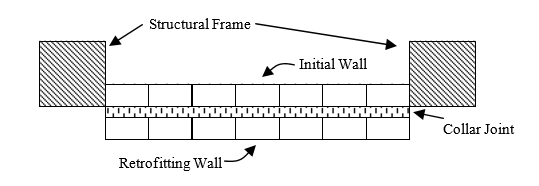S. Michos1 and J. P. Forth2
- PhD Student, Department of Civil Engineering, University of Leeds, Leeds, LS2 9JT, UK, cen1s3m@leeds.ac.uk
- Senior Lecturer, Department of Civil Engineering, University of Leeds, Leeds, LS2 9JT, UK, j.p.forth@leeds.ac.uk
ABSTRACT
The mechanical behaviour of un-reinforced masonry walls subject to quasi-static and dynamic loading is difficult to assess in practice due to a) the inherent unpredictability and variability associated with the performance of the bricks and the mortar both individually and as a composite material b) the difficulty of correctly identifying the boundary conditions and reproducing these under laboratory conditions. Recently, a more ‘basic’ retrofitting technique that involves building a second masonry panel, parallel to an existing one (i.e. collar-jointed masonry), in order to enhance the behaviour of the existing wall has been trialled in certain real structures. The new leaf is tied to the old panel by means of the collar joint and/or by steel ties.
To assess this practical approach, tests were performed on three different arrangements, namely 1) collar joint without ties, 2) collar joint with ties and 3) ties without a collar joint; all walls were subject to quasi-static loading. The aim was to evaluate the shear capacity of the bond between the two panels, to assess the suitability of such a technique and to establish whether or not there is a need for ties in conjunction with a collar joint. This paper describes the development of a laboratory testing rig which can be used to accurately assess these criteria. Preliminary results illustrate that the test setup to represent the real life situation has been identified and gives consistent results. Also, the use of steel ties with a completely filled collar joint seems to be unnecessary.
KEYWORDS: collar jointed masonry, ties, shear capacity
C8-3



